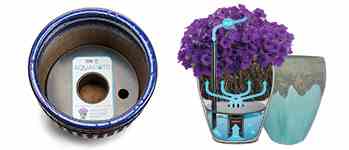Mulch 101: How & When to Mulch Your Yard
Learn how and when to mulch for healthy plants and a beautiful landscape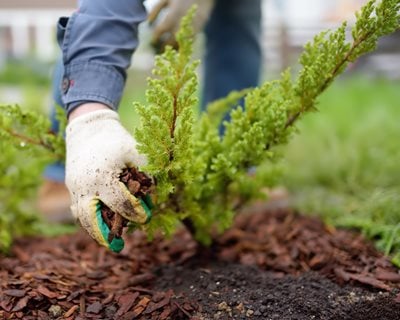
Photo by: Maria Sbytova / Shutterstock.
Mulching is crucial to the health and appearance of your yard. This basic garden technique, where a layer of materials is laid on top of the soil surface, suppresses weeds, retains moisture, and regulates temperatures in the root zone. Other benefits of mulch include controlling water runoff and erosion, improving soil tilth, reducing maintenance, and preventing germination of weed seeds. Mulch also adds curb appeal to beds and borders.
The two primary types of mulch are organic and inorganic. Organic mulches are comprised of plant materials such as shredded bark, wood chip pieces, compost, manure, fallen leaves, grass clippings, straw, and pine needles. Inorganic mulches are inert materials such as gravel, rock, landscape fabric, and plastic. (See more on the different types of mulch)
How and when to mulch your yard is just as important as what kind of mulch to use. Here are tips on using mulch in your landscape.
HOW TO APPLY MULCH
Check out these tips for applying bark mulch.
For organic materials, apply mulch in a 2- to 4-inch-deep layer. For a finer mulch such as compost, a 2-inch layer of mulch is sufficient. Coarser materials such as wood chips or straw can be applied up to 4 inches deep. Inorganic mulch such as gravel or stone can be applied 1 to 2 inches deep. For winter protection in colder climates, use mulch in thick layers to insulate plants.
Too much mulch can result in root suffocation and difficulty for water and fertilizer to penetrate the soil surface. Deeper mulch may also attract pests. Mulch that is applied too thinly may be less effective at controlling weeds.
Use a shovel, pitchfork, or your hands to distribute mulch around plants. Rake mulch into an even layer. Use gloves to protect your hands.
When laying mulch, keep it several inches away from plant trunks or crowns to prevent rot or stunting of growth, and to deter pests and diseases. Make sure mulch is 6 to 12 inches away from building foundations.
Don’t pile mulch over the top of young seedlings, as it can smother plants.
Lightly turn organic mulch periodically to aerate, freshen the appearance, and help prevent pests and diseases.
WHEN TO APPLY MULCH
The best time to apply mulch is in spring or fall.
- Spring mulching: In most regions, it’s best to wait until mid to late spring to allow the soil to warm up. Applying mulch too early can slow soil warming and delay plant growth. Also in spring, pull back any heavy mulch that was applied in fall from around the base of plants to allow soil to warm up more quickly.
- Fall mulching: Lightweight organic materials such as fallen leaves, pine needles, straw, and grass clippings help to insulate plant roots over the colder months and moderate freeze/thaw cycles that can heave plants out of the ground. Wait until after the first hard freeze to apply fall mulch. (Note: Grafted roses need a deeper layer of mulch to prevent the graft from freezing.) Shredded leaves, compost, or grass clippings can be spread on top of vegetable beds to break down over the winter, creating nutrient-rich beds in time for spring planting.
RIGHT MULCH, RIGHT PLACE
The type of mulch to use depends on the areas being mulched and what your goal is. A mulch for trees and shrubs will be different than a mulch for vegetable plots. Organic mulch will improve soil and plant health, while inorganic mulch provides no soil improvement.
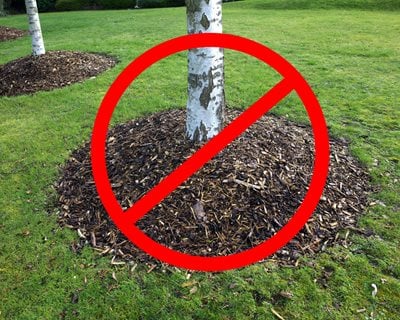
Photo by: Thinglass / Shutterstock.
- Trees, shrubs, foundation plantings, and shrub borders: Shredded bark or bark chips are the most common types of mulches for trees and shrubs, adding a decorative touch to the landscape. Avoid piling mulch high around the base of tree trunks, which is known as volcano mulching. This can result in rot or damage from rodents and wood-boring insects. Apply 2 to 3 inches of mulch out to the drip line (outer circumference of the branches), and keep mulch several inches away from the base of trees and shrubs.
- Garden beds and mixed borders: Ornamental beds will benefit from a yearly application of a nutrient-rich mulch such as compost or shredded bark that will break down quickly. Avoid placing mulch directly over the crown of herbaceous perennials, which can delay growth. Two to three inches of mulch is sufficient.
- Vegetable plots: Edible crops grow quickly and need lots of nutrients and water to thrive. Use mulch such as compost, straw, and grass clippings that will decompose quickly to nourish plants. For perennial edible crops such as berry shrubs and fruit trees, use wood products such as chips or shredded bark that will break down more slowly. Avoid placing mulch that has been treated with pesticides or other chemicals on edible crops. In fall, old mulch can be dug into the soil to decompose and enrich the soil over winter.
- Pathways: The best organic materials for pathways are shredded bark or wood chips. These will need replenishing every 1 to 2 years, depending on the size of the material. Wood chips will last longer than shredded bark. Apply a 2- to 3-inch layer and spread evenly for the best footing. Gravel and crushed stone are longer lasting and permeable, allowing good drainage. Use 1 to 2 inches of stone material and rake out into an even layer.
How much mulch do you need?
Enter depth, width, and length of your area to find cubic yards, meters, or bags of mulch needed for your project.

CONSIDERATIONS WHEN CHOOSING & USING MULCH
Here are some things to consider when using mulch:
- Avoid chemically treated products. Synthetic mulch such as landscape fabric, rubber, and plastic can leach chemicals into the soil, harming beneficial soil organisms and polluting the soil. Don’t place treated grass clippings or other organic material around edible crops. Avoid using wood products that have been treated with dyes or other chemicals.
- Protect pets. Some dogs like to chew and swallow wood chips or rocks, which can cause life-threatening digestive issues. Cocoa bean mulch contains toxic compounds that can be harmful to dogs and cats.
- Climate and regional differences:
- Dark mulch such as black plastic or darker colored rock may be beneficial in cooler climates to help warm the soil, but can overheat in hotter regions, damaging plant roots. Light-colored mulches are reflective and will stay cooler.
- Dry mulch such as sawdust, wood chips, and straw may become a fire hazard in hot, dry climates. Keep mulch away from homes, garages, and outbuildings or use a less flammable mulch.
- Wood products are commonly used in northern climates, while pine straw is more readily available and used in the south.
- Inorganic mulching with gravel and rock mulch is more typical in desert regions and with waterwise landscapes where plants have lower maintenance needs.
PREPARING BEDS FOR MULCHING
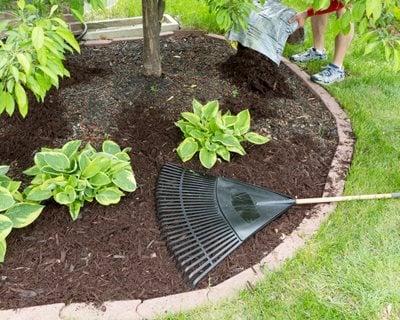
Photo by: Ozgur Coskun / Shutterstock.
Take these steps to prepare beds before applying mulch:
- Remove weeds so there’s less chance of weeds growing through the mulch.
- Clean up leaf or other debris on the soil surface.
- Prune out any dead, damaged, or diseased growth on trees, shrubs, and perennials.
- Remove old mulch, which may harbor pests and diseases. Dispose of old mulch if suspected to have pests or diseases. Clean mulch can be dug into the soil to provide nutrients, or added to the compost pile.
- Rake the soil to level out the surface and remove any large rocks.
- If soil is dry, water the area thoroughly to moisten before applying mulch.
- In weedier areas, spread a layer of newspapers on the surface of the soil before applying mulch.
HOW OFTEN TO REPLACE MULCH
Organic mulches break down and will need replenishing more frequently than inorganic mulches such as rocks or stone. Finer mulch such as shredded bark, compost, and grass clippings decompose more quickly than chunky wood chips. Larger chips will last longer than smaller pieces.
Replenish mulch when it becomes thin or you see bare spots. Finer mulch will need replenishing every 1 to 2 years; larger wood chips may last several years. Inorganic mulch is intended to be more permanent.
POSSIBLE MULCHING PROBLEMS
- Too much mulch can impede the flow of water and nutrients, attract pests, or suffocate dormant and newly emerging plants, delaying growth. Apply no more than 2 to 4 inches of mulch and avoid placing mulch against the base of trees and shrubs or on top of perennial crowns.
- Matting can occur with some mulches, including garden waste materials such as leaves and grass clippings. This can impede the flow of water and nutrients to the root zone. Rake mulch periodically to aerate. A mulching mower can be used to shred leaves into into smaller pieces, making them less likely to become matted and allowing them to break down faster to nourish the soil.
- Mold or fungi may form on mulch if it stays too moist. In shadier areas that take longer to dry out, apply mulch in a thinner layer. Rake mulch periodically to aerate and reduce watering. If the problem persists, remove old mulch and lay it on a tarp in a sunny spot for 1 to 2 weeks to dry out, then reapply. It can also be replaced with fresh mulch.
- Insects including harmful pests such as termites are attracted to moist, dark conditions and may burrow underneath mulch. To deter insects, add mulch in a thinner layer and rake periodically to aerate. Aromatic wood mulches such as cedar, cypress and eucalyptus help to repel pests. Keep mulch 6 to 12 inches away from building foundations.
- Burning of plant roots or leaves can occur if manure mulch is not aged enough. Purchase finished manure in bags or in bulk from soil companies. If using farm manure, allow it to age 1 to 2 years before using.
FREQUENTLY ASKED QUESTIONS
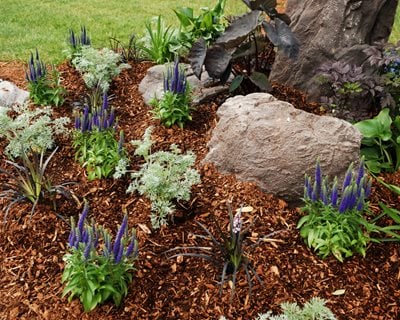
Photo by: Lijuan Guo / Shutterstock.
What should I put down before mulching?
For a more long-term solution to weed suppression, landscape fabric can be laid on the soil surface before applying organic or inorganic mulch.
Can I put mulch directly on the ground?
In most cases, mulch is laid directly on the soil surface. For better weed suppression, spread a layer of newspaper or cardboard on the soil surface and cover with compost, bark, or other organic materials.
How do you prepare ground for mulch?
Remove weeds and other debris and even out the soil surface before applying mulch. If the soil is dry, moisten the area first.
RELATED:
Types of Mulch
Low-Maintenance Gardening Tips
How to Make Your Own Compost
